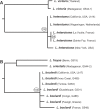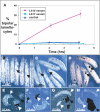Contrasting infection strategies in generalist and specialist wasp parasitoids of Drosophila melanogaster
- PMID: 17967061
- PMCID: PMC2042021
- DOI: 10.1371/journal.ppat.0030158
Contrasting infection strategies in generalist and specialist wasp parasitoids of Drosophila melanogaster
Abstract
Although host-parasitoid interactions are becoming well characterized at the organismal and cellular levels, much remains to be understood of the molecular bases for the host immune response and the parasitoids' ability to defeat this immune response. Leptopilina boulardi and L. heterotoma, two closely related, highly infectious natural parasitoids of Drosophila melanogaster, appear to use very different infection strategies at the cellular level. Here, we further characterize cellular level differences in the infection characteristics of these two wasp species using newly derived, virulent inbred strains, and then use whole genome microarrays to compare the transcriptional response of Drosophila to each. While flies attacked by the melanogaster group specialist L. boulardi (strain Lb17) up-regulate numerous genes encoding proteolytic enzymes, components of the Toll and JAK/STAT pathways, and the melanization cascade as part of a combined cellular and humoral innate immune response, flies attacked by the generalist L. heterotoma (strain Lh14) do not appear to initiate an immune transcriptional response at the time points post-infection we assayed, perhaps due to the rapid venom-mediated lysis of host hemocytes (blood cells). Thus, the specialist parasitoid appears to invoke a full-blown immune response in the host, but suppresses and/or evades downstream components of this response. Given that activation of the host immune response likely depletes the energetic resources of the host, the specialist's infection strategy seems relatively disadvantageous. However, we uncover the mechanism for one potentially important fitness tradeoff of the generalist's highly immune suppressive infection strategy.
Conflict of interest statement
Figures







References
-
- LaSalle J, Gauld ID. Hymenoptera, their diversity and their impact on the diversity of other organisms. In: LaSalle J, Gauld ID, editors. Hymenoptera and biodiversity. Wallingford (United Kingdom): CAB International; 1993. pp. 1–26.
-
- Carton Y, Bouletreau M, van Alphen JJM, van Lenteren JC. The Drosophila parasitic wasps. In: Ashburner M, Carson L, Thompson JN, editors. The genetics and biology of Drosophila. London: Academic Press; 1986. pp. 347–394.
-
- Fleury F, Ris N, Allemand R, Fouillet P, Carton Y, et al. Ecological and genetic interactions in Drosophila-parasitoids communities: a case study with D. melanogaster, D. simulans and their common Leptopilina parasitoids in south-eastern France. Genetica. 2004;120:181–194. - PubMed
-
- Boutros M, Agaisse H, Perrimon N. Sequential activation of signaling pathways during innate immune responses in Drosophila. Dev Cell. 2002;3:711–722. - PubMed
Publication types
MeSH terms
Substances
Associated data
- Actions
- Actions
- Actions
Grants and funding
LinkOut - more resources
Full Text Sources
Molecular Biology Databases

